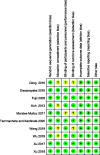The role of perioperative intravenous low-dose dexamethasone in rapid recovery after total knee arthroplasty: a meta-analysis
- PMID: 33685282
- PMCID: PMC7952853
- DOI: 10.1177/0300060521998220
The role of perioperative intravenous low-dose dexamethasone in rapid recovery after total knee arthroplasty: a meta-analysis
Abstract
Purpose: The purpose of this meta-analysis was to evaluate the overall safety and effectiveness of perioperative intravenous dexamethasone to facilitate postoperative rehabilitation in patients after total knee arthroplasty (TKA).
Methods: A comprehensive literature search was performed using the Embase, PubMed, Cochrane Library, and China National Knowledge Infrastructure (CNKI) databases for relevant randomized controlled trials (RCTs) from inception to 2020. Methodological quality of the trials was assessed using the Cochrane Risk of Bias Tool, and the relevant data were extracted using a predefined data extraction form.
Results: Ten RCTs with 1100 knees were included. Our study showed a significant reduction in pain using a postoperative pain visual analog scale (VAS) at 24 hours and 48 hours, total opioid consumption at 24 hours and 48 hours, postoperative nausea and vomiting (PONV), active range of motion (ROM) limitation, and passive ROM limitation at 72 hours in dexamethasone-treated groups compared with controls.
Conclusion: Intravenous low-dose dexamethasone is potentially useful in the perioperative setting for reducing postsurgical immediate ROM limitations, pain, opioid consumption, and PONV. There are no data that directly attribute an increase in postoperative complications to intravenous dexamethasone. More high-quality studies are necessary to draw these conclusions.
Keywords: Intravenous dexamethasone; low-dose; meta-analysis; opioid consumption; pain; postoperative nausea and vomiting; range of motion; rapid recovery; total knee arthroplasty.
Conflict of interest statement
Figures










Similar articles
-
A systematic review and meta-analysis on the effects of intravenous dexamethasone on postoperative outcomes in patients undergoing total knee arthroplasty.Langenbecks Arch Surg. 2025 Jan 24;410(1):49. doi: 10.1007/s00423-025-03618-7. Langenbecks Arch Surg. 2025. PMID: 39856374 Free PMC article.
-
Effect of Intravenous Dexamethasone on Postoperative Pain in Patients Undergoing Total Knee Arthroplasty: A Systematic Review and Meta-Analysis.Pain Physician. 2022 Mar;25(2):E169-E183. Pain Physician. 2022. PMID: 35322969
-
Preoperative intravenous glucocorticoids can reduce postoperative acute pain following total knee arthroplasty: A meta-analysis.Medicine (Baltimore). 2017 Sep;96(35):e7836. doi: 10.1097/MD.0000000000007836. Medicine (Baltimore). 2017. PMID: 28858092 Free PMC article.
-
A meta-analysis of dexamethasone for pain management in patients with total knee arthroplasty.Medicine (Baltimore). 2018 Aug;97(35):e11753. doi: 10.1097/MD.0000000000011753. Medicine (Baltimore). 2018. PMID: 30170371 Free PMC article. Review.
-
Additional Dose of Intravenous Dexamethasone Can Replace Patient-Controlled Analgesia in Pain Control after Total Knee Arthroplasty while Reducing Opioid Complications.J Knee Surg. 2025 Jun;38(7):351-359. doi: 10.1055/a-2509-3502. Epub 2025 Jan 3. J Knee Surg. 2025. PMID: 39753150
Cited by
-
The Effect of Dexamethasone on Postoperative Pain Management in Patients Undergoing Total Knee Arthroplasty: A Randomized Controlled Trial.Cureus. 2023 Apr 3;15(4):e37052. doi: 10.7759/cureus.37052. eCollection 2023 Apr. Cureus. 2023. PMID: 37143623 Free PMC article.
-
Perioperative dexamethasone: Effects on length of stay, perioperative outcomes, and safety in isolated lower extremity long bone fracture fixation.J Clin Orthop Trauma. 2025 May 20;67:103067. doi: 10.1016/j.jcot.2025.103067. eCollection 2025 Aug. J Clin Orthop Trauma. 2025. PMID: 40503003
-
A systematic review and meta-analysis on the effects of intravenous dexamethasone on postoperative outcomes in patients undergoing total knee arthroplasty.Langenbecks Arch Surg. 2025 Jan 24;410(1):49. doi: 10.1007/s00423-025-03618-7. Langenbecks Arch Surg. 2025. PMID: 39856374 Free PMC article.
-
Should we use similar perioperative protocols in patients undergoing unilateral and bilateral one-stage total knee arthroplasty?World J Orthop. 2022 Jan 18;13(1):58-69. doi: 10.5312/wjo.v13.i1.58. eCollection 2022 Jan 18. World J Orthop. 2022. PMID: 35096536 Free PMC article.
-
Effect of preoperative single-dose methylprednisolone administration on early postoperative pain following retrograde intrarenal surgery.Int Urol Nephrol. 2024 Apr;56(4):1253-1258. doi: 10.1007/s11255-023-03875-9. Epub 2023 Nov 24. Int Urol Nephrol. 2024. PMID: 37999826
References
-
- Kim S. Changes in surgical loads and economic burden of hip and knee replacements in the US: 1997–2004. Arthritis Rheum 2008; 59: 481–488. - PubMed
-
- Kurtz S, Ong K, Lau E, et al.. Projections of primary and revision hip and knee arthroplasty in the United States from 2005 to 2030. J Bone Joint Surg Am 2007; 89: 780–785. - PubMed
-
- Sinatra RS, Torres J, Bustos AM. Pain management after major orthopaedic surgery: current strategies and new concepts. J Am Acad Orthop Surg 2002; 10: 117–129. - PubMed
-
- Lakra A, Murtaugh T, Shah RP, et al.. Early postoperative pain predicts 2-year functional outcomes following knee arthroplasty [published online ahead of print, 2019 Jul 3]. J Knee Surg 2019; 10.1055/s-0039-1692650. - PubMed
Publication types
MeSH terms
Substances
LinkOut - more resources
Full Text Sources
Other Literature Sources
Medical

